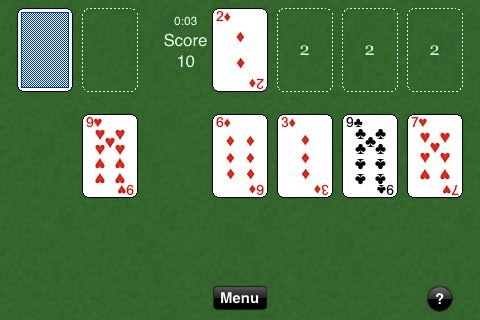
Racing Demons is a variant of Canfield, and rules for both games are explained here.
When you start the game, you will see the basic layout of Canfield solitaire on your screen: The deck in the upper left corner, the four foundations to the right of the deck, the stock below the deck, and the four columns of the tableau below the foundations.

As the game begins, iKlondike deals seventeen cards from the deck: thirteen into the stock and one into each column in the tableau. For the Canfield game, iKlondike also deals one card to the first foundation. For Racing Demons, the foundations must start with the Ace of each suit, but iKlondike does not deal a card to the first foundation. All cards are face up.
The object of the game is to build all the cards face up on the foundations. Each foundation builds upward, in sequence, starting with the base card for the foundations. For Canfield, the base is established when iKlondike deals a card to the first foundation. For Racing Demons, the base is always the Ace. iKlondike shows the value which must be used to start each foundation pile in the empty foundations.
Only the next higher card of the same suit can be added to each foundation, with the Ace playing on the King. Cards may be moved to the foundation from the tableau, the deck or the stock.
You advance the game by building on the face-up cards in the tableau in descending sequence of alternating colors. For example, only the 9 of hearts or diamonds (red suits) may play on the 10 of spades (a black suit). Cards can be built on the tableau piles by moving them from another tableau pile, the top of the stock, or the top of the turned up cards from the deck. Any uncovered card is always available to play to a foundation.
According to strict Canfield and Racing Demons rules, all the face-up cards in a column must be moved as a unit to another column. To move fewer than all the face-up cards, tap and hold on the column until the card you tapped ʽpops out’ from the column. Move your finger up or down the column so that the deepest card you wish to move is popped out, then drag the partial column to the left or right to the desired destination.
Whenever all the cards in a column are moved, the top card of the stock may be moved into the empty column. Once the stock has been exhausted, the empty column may be filled from the deck.
If you select Casino Scoring in Settings, the game is scored according to a casino scheme: You “pay” 52 points to deal a new hand, and you “win” 5 points for each card played on the foundations.
Regular scoring is more like a video game, including a penalty for slow play, as follows:
For each card played to the foundations, you will receive 10 points.
For each card added to the tableau piles, you will receive 5 points. This can be either from moving a turned-up card from the deck to a tableau pile, or by turning up one of the face-down cards in the tableau.
For each 15 seconds of play, you lose 2 points.
If you win the game, iKlondike will notice and finish moving all the cards to the foundations for you (provided the Autocomplete option is selected in Settings). You will then receive a winning bonus of 10 * (final score - number of seconds played). If the Autocomplete option is not selected, you must move all the cards to the foundations yourself before receiving the winning bonus.
You can view the top ten scores you have achieved for the game by tapping History on the Menu toolbar. Details include the date and time the game ended, and the elapsed playing time. Scores for games which you did not win are shown in red.
For more information about iKlondike’s history, rules and scoring, visit the Klondike home page.
Email support: iklondike@casteel.org.